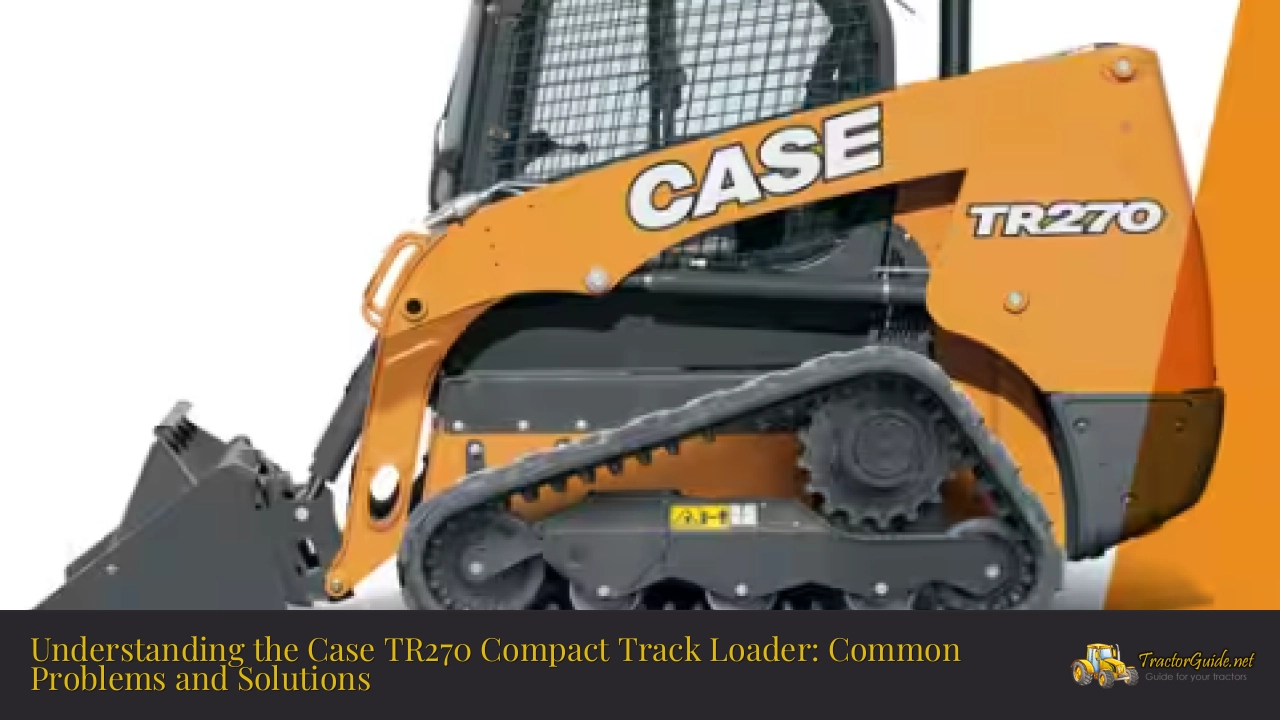The Case TR270 compact track loader is a powerful machine widely used in various industries, including landscaping, construction, and agriculture. Known for its robust performance and versatility, the TR270 is designed to handle a myriad of tasks efficiently. However, like any heavy machinery, it is not without its issues. This article delves into the common problems faced by users of the Case TR270, explores their causes, and provides practical solutions to ensure optimal performance.
Common Problems with the Case TR270
The following table summarizes some frequently encountered issues with the Case TR270 along with their potential causes and solutions.
| Problem | Possible Causes | Solutions |
|---|---|---|
| Engine Won’t Start | Fuel system issues, faulty glow plugs | Check fuel filters and glow plugs; ensure connections are secure. |
| Hydraulic System Failure | Low hydraulic fluid level, clogged filters | Regularly check fluid levels; replace clogged filters. |
| Control System Malfunctions | Loose connections, faulty joystick controls | Inspect wiring and connections; replace faulty components. |
| Overheating | Dirty air filters, low coolant levels | Clean or replace air filters; check coolant levels regularly. |
| Uneven Track Wear | Improper weight distribution, lack of maintenance | Regularly inspect tracks; ensure proper loading practices. |
Detailed Analysis of Common Issues
Engine Problems
One of the most prevalent issues reported by users is engine failure to start. This problem can stem from several factors:
- Fuel System Issues: A clogged fuel filter or a malfunctioning fuel pump can prevent the engine from receiving adequate fuel. Regular maintenance of the fuel system is crucial.
- Glow Plug Malfunctions: In colder climates, glow plugs are essential for warming the engine’s combustion chambers. If they are faulty or loose, they may not heat properly, leading to starting issues.
To address these problems, operators should conduct regular inspections of the fuel system, including filters and lines, ensuring they are clean and functional.
Hydraulic System Issues
The hydraulic system is vital for the loader’s performance. Common hydraulic problems include:
- Low Fluid Levels: Insufficient hydraulic fluid can lead to decreased power and responsiveness. Operators should regularly check fluid levels and refill as necessary.
- Clogged Filters: A clogged hydraulic filter can restrict fluid flow, causing performance issues. Regular replacement of these filters is recommended.
Operators should also inspect hydraulic lines for leaks or damage to maintain optimal performance.
Control System Malfunctions
Control system issues can significantly impact operational efficiency. Common symptoms include unresponsive joystick controls or delayed responses:
- Loose Connections: Loose wiring or connections between the joystick and hydraulic pump can cause control failures. Regular checks can help identify and rectify these issues.
- Faulty Components: If connections are secure but problems persist, it may be necessary to replace components within the control system.
Ensuring that all electrical connections are tight and functional is key to maintaining control system integrity.
Overheating Issues
Overheating can occur due to various reasons:
- Dirty Air Filters: Clogged air filters restrict airflow to the engine, causing it to overheat. Regular cleaning or replacement of air filters can prevent this issue.
- Low Coolant Levels: Insufficient coolant can lead to engine overheating. Operators should routinely check coolant levels and top off as necessary.
Uneven Track Wear
Uneven wear on tracks can lead to costly replacements and operational inefficiencies:
- Improper Weight Distribution: Overloading one side of the machine can cause uneven wear on tracks. Operators should ensure proper loading techniques are followed.
- Lack of Maintenance: Regular inspections of tracks for wear and damage are essential for longevity.
Preventive Maintenance Recommendations
To avoid common problems with the Case TR270, operators should adhere to a strict preventive maintenance schedule:
- Regular Inspections: Conduct thorough inspections of all systems including engine, hydraulics, and controls at regular intervals.
- Fluid Checks: Monitor fluid levels in both the engine and hydraulic systems frequently.
- Filter Replacements: Change air and fuel filters as recommended by the manufacturer to ensure optimal performance.
- Track Maintenance: Regularly inspect tracks for wear and ensure proper tensioning to extend their lifespan.
- Operator Training: Ensure that all operators are trained in proper loading techniques and equipment handling to minimize wear and tear.
Conclusion
The Case TR270 compact track loader is a reliable piece of machinery that offers exceptional versatility in various applications. By understanding common problems associated with this model and implementing effective maintenance strategies, operators can enhance productivity while minimizing downtime due to repairs.
Investing time in preventive measures not only prolongs the life of the equipment but also ensures that it operates at peak performance when needed most.
FAQs
What should I do if my TR270 won’t start?
Check the fuel system for clogs and inspect glow plugs for functionality.
How often should I change my hydraulic fluid?
It’s recommended to change hydraulic fluid every 1,000 hours of operation or as specified in your manual.
What causes uneven track wear?
Improper weight distribution during operation is a common cause of uneven track wear.
How can I improve visibility when operating the TR270?
Ensure that mirrors are adjusted properly and keep windows clean for better sightlines.
What maintenance tasks should I prioritize?
Focus on regular inspections of fluids, filters, tracks, and control systems for optimal performance.
